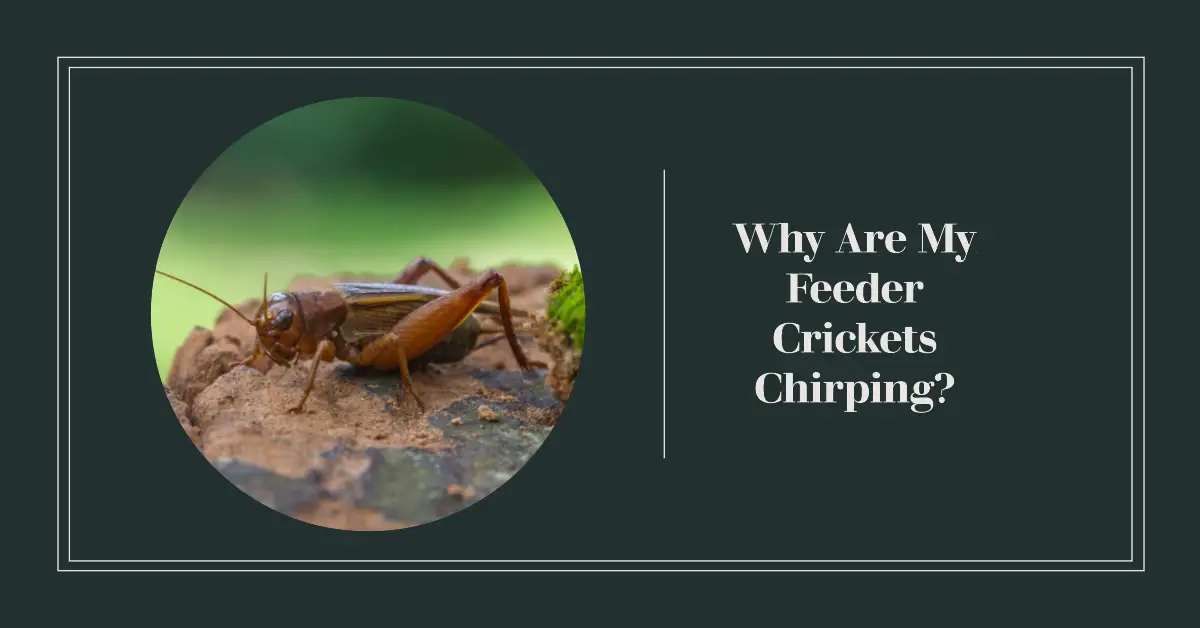
Jeffery Jago is a expert in horticulture and worm breeding. With a background in plant cultivation
Last Updated on March 27, 2023 by Jeffery Jago
Feeder crickets are commonly used as a nutritious food source for reptiles, amphibians, and other insectivorous pets.
However, many pet owners may be puzzled by the chirping sounds that their feeder crickets make.
In this article, we will explore the reasons behind cricket chirping, discuss how it relates to cricket biology, and offer tips on managing the noise associated with these fascinating insects.

The Science Behind Cricket Chirping
Crickets produce their distinct chirping sound through a process called stridulation. Male crickets have a series of ridges, or teeth, on the underside of one wing, which they rub against a scraper on the other wing to create the familiar sound.
Chirping plays a crucial role in cricket communication and mating. It is important to note that only crickets in the final instar, or the last stage of development before becoming adults, have the ability to chirp.
The sound produced by crickets is determined by several factors, including the species of cricket, the temperature, and the time of day.
In general, crickets produce more chirps at higher temperatures, as the heat causes their metabolic rate to increase and stimulates their chirping behavior.
Additionally, different species of crickets have distinct chirping patterns, allowing them to communicate and identify potential mates.
Female crickets are able to distinguish between the chirping patterns of different male crickets, using this information to select a mate.
In some cases, female crickets may even be able to judge the quality of a male based on the characteristics of his chirping, such as the regularity and consistency of the sound.
The study of cricket chirping and communication has also provided insights into broader biological and evolutionary questions. For example, research has shown that some species of crickets are able to adjust their chirping behavior in response to environmental cues, such as the presence of predators or the density of other crickets in their area.
This suggests that crickets have a degree of behavioral flexibility that allows them to adapt to changing conditions and maximize their chances of survival and reproduction.
Overall, the process of cricket stridulation and chirping is a fascinating example of the complex communication and behavioral patterns that can be found in insects.
The study of cricket chirping has provided important insights into the mechanisms of communication and mating in animals, as well as the broader ecological and evolutionary factors that shape these behaviors.
Common Reasons for Feeder Crickets Chirping
Male crickets use chirping as a means of attracting females for mating. The sound produced by male crickets can be heard over a distance, allowing them to signal their presence to potential mates.
The chirping pattern of male crickets can vary depending on the species, and females are often able to distinguish between the chirping patterns of different males, using this information to select a mate.
In addition to mating purposes, crickets may also chirp in response to changes in their environment, such as temperature or humidity. For example, crickets may become more active and chirp more frequently when the temperature rises, as this stimulates their metabolic rate and promotes their activity levels.
Similarly, changes in humidity can also affect cricket chirping behavior, as crickets may become more vocal when the air is more humid.
Chirping can also serve as a means of communication among crickets. For example, crickets may chirp to signal danger or warn other crickets of potential threats. Additionally, some species of crickets may chirp as a form of self-defense, as the sound may startle or deter predators.
Overall, chirping is an important part of cricket behavior and communication, serving a variety of functions related to mating, environmental adaptation, and self-defense.
The Impact of Cricket Chirping on Feeder Cricket Health and Quality
However, excessive chirping can also be a sign of stress and overcrowding among feeder crickets. Crickets that are overcrowded or kept in poor conditions may become stressed and produce a high-pitched, continuous chirping sound.
This can indicate that the crickets are not receiving adequate space, food, or water, which can ultimately lead to a decline in their health and nutritional value.
In addition, it is important to note that chirping itself does not necessarily indicate the nutritional quality of feeder crickets.
While active crickets may produce more nutrients, it is also important to ensure that they are receiving a balanced diet and proper hydration to maximize their nutritional value.
Overall, while chirping can be an indicator of healthy and active feeder crickets, it is important to ensure that they are kept in optimal conditions and provided with a balanced diet to ensure their health and nutritional value.
Tips for Managing Chirping in Feeder Crickets
To manage the noise produced by chirping crickets, consider the following tips:
- Provide a suitable environment: Reducing stress-induced chirping can be achieved by ensuring that your cricket keeper is well-ventilated and maintained at appropriate temperature and humidity levels.
- Use sound-dampening materials: Adding sound-dampening materials, such as foam or fabric, to the cricket keeper or surrounding area can help to minimize the noise.
- Purchase younger crickets: To avoid the chirping associated with mature crickets, consider purchasing younger crickets and using them as feed before they reach their final instar and develop the ability to chirp.
- Feed crickets a balanced diet: Providing crickets with a balanced diet can help to minimize stress and reduce excessive chirping. Consider using a high-quality commercial cricket feed or providing fresh fruits and vegetables.
- Avoid overcrowding: Overcrowding can lead to stress-induced chirping, so make sure to provide adequate space for your crickets based on their age and size.
Managing chirping in feeder crickets requires careful attention to their environment and diet. By taking steps to minimize stress and provide a balanced diet, you can help to reduce excessive chirping and ensure that your feeder crickets are healthy and nutritious for your pets.
Best Locations to Place Cricket Keepers to Minimize Noise
To further minimize cricket noise, consider placing your cricket keeper in low-traffic areas of your home, such as a basement or garage.
This will help to keep the noise away from your main living spaces. Additionally, you can employ soundproofing techniques, such as using acoustic panels or insulation, to minimize cricket noise in shared spaces.
Just be sure to keep humidity, temperature, and ventilation in mind when selecting a location for your cricket keeper.
It is important to place the cricket keeper in an area with good ventilation and appropriate temperature and humidity levels to ensure the health and well-being of the crickets.
For example, placing the cricket keeper near a window or air conditioning unit can help to regulate the temperature and humidity levels. It is also important to keep the cricket keeper away from direct sunlight or sources of heat, as this can cause the temperature to rise too high and harm the crickets.
Overall, selecting an appropriate location for your cricket keeper can help to minimize noise and ensure the health and well-being of your feeder crickets. By keeping these factors in mind, you can create an optimal environment for your crickets and reduce the impact of their noise on your home.
Embracing Cricket Chirping as a Natural Part of Feeder Cricket Care
Chirping is a natural part of cricket behavior and biology. While it might be surprising or even annoying at times, understanding that some level of chirping is normal and expected in feeder cricket populations can help pet owners appreciate these insects for their unique characteristics.
Conclusion
Understanding the reasons behind feeder cricket chirping and its significance can help pet owners better manage and care for these insects.
By recognizing the role of chirping in cricket biology and implementing noise reduction strategies, you can create a more pleasant environment for both you and your insectivorous pets.
Proper cricket care and management not only ensure a more enjoyable experience for you but also contribute to the overall health and well-being of your feeder cricket population.


